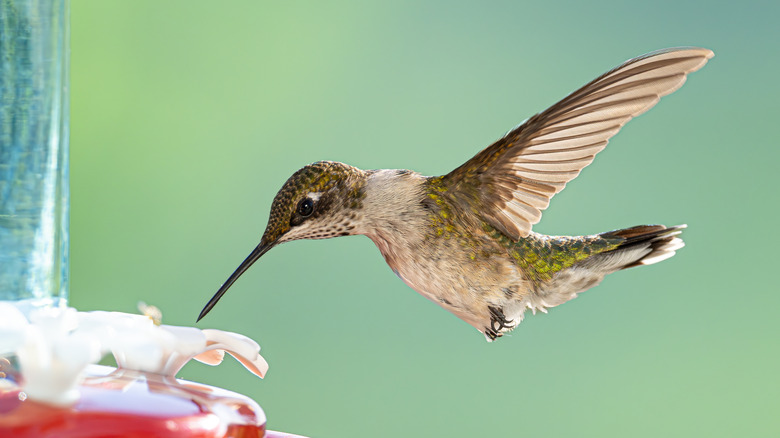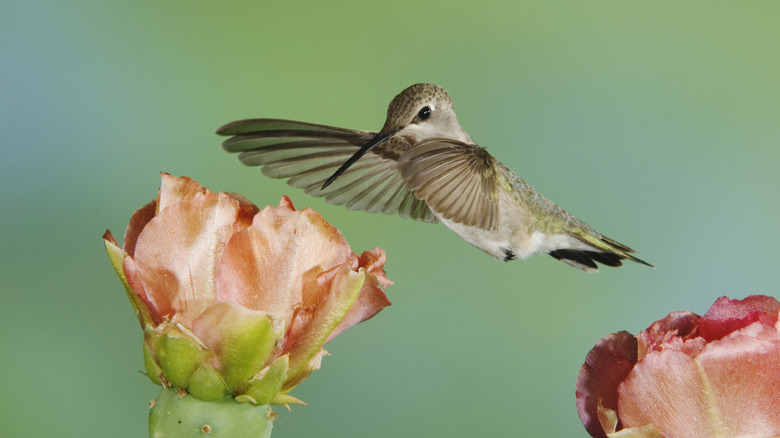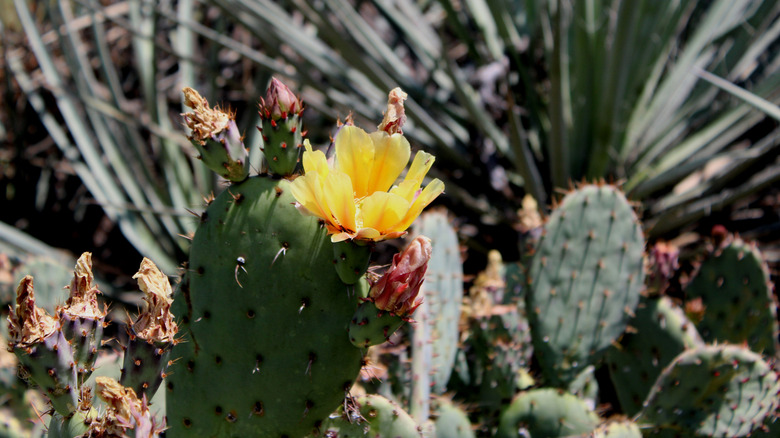The Popular Variety Of Cactus That Attracts Hummingbirds To Your Yard
If you're a lover of cacti (Cactaceae spp.), then you're probably familiar with prickly pear plants (Opuntia spp.). Native to the Americas, this perennial succulent is beloved by gardeners in subtropical or tropical climates for its durability, bright-colored flowers, and edible pads and fruits. But did you know that prickly pear plants will attract hummingbirds and pollinators too? That's right: Hummingbirds (Trochilidae spp.), like humans, appreciate this cactus's showy blooms. So, if you're looking to see more hummingbirds in your garden, this fruit-bearing plant is one option to consider.
Prickly pear plants are suitable for USDA Hardiness Zones 3B through 11 (though, in Zones 7 through 11, they'll thrive outdoors year round). Depending on the subspecies, they can reach heights of 15 feet, though most hover between 3 to 8 feet tall. They're slow growers and can take years to bloom or bear fruit. However, since prickly pear plants are desert-dwelling cacti, they're naturally hardy and drought-resistant. Put in a little work upfront, be patient, and you can enjoy the literal fruits of your labor — while drawing hummingbirds — for years to come.
The reason why hummingbirds love prickly pear plants
Dainty in size and stature and known for their distinctive long beaks, hummingbirds burn a ton of energy by buzzing around during the day. If you've ever seen one in the wild, then you know how impressively fast and agile they are compared to other birds. They keep up with their wickedly fast metabolism by both nibbling on insects and feasting on the natural sugars in many flower- and fruit-bearing plants — including prickly pear plants.
When in bloom, these cacti's sweet, bright-colored flowers are a magnet for hummingbirds, who are drawn in by the saccharine nectar they contain. It provides key nutrients that these birds need to replenish their oft-depleted energy stores as they go about their day. Since they're so small and nimble, hummingbirds are easily able to dodge the plant's sharp spines and get straight to the good stuff. Fun fact: Prickly pear plants also attract bees, who flock to their fruits and flowers for the very same reason. Plant them, and you'll keep your garden full of pollinators.
How to grow and tend to prickly pear plants
Fair warning, prickly pear plants aren't suitable for all environments. If you're planting them outdoors, make sure you live in a climate that's hot and dry enough to support them. You can plant them from cuttings or replant them from a pot straight into your garden. Choose a sun-drenched spot, and plant them in soil that's mixed with sand, drains well, and in a hole that's super shallow (i.e., only about an inch deep). You don't have to be precious with them or even monitor them. Some gardeners recommend tossing a pad from an existing prickly pear plant in the spot where you want it to grow and forgetting about it.
To that end, you'll want to leave your prickly pear plant unwatered for a month after planting. They might look sick or withered at first, but don't fret — that's because this nascent plant is using all its nutrients to establish a root system underground. Once established, these cacti should be watered sparingly and only once the soil has dried out entirely. And that's really all there is to it. Gotta love naturally drought-resistant plants that will thrive without much water.


